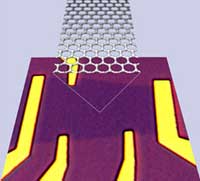Mar 28 2008
Research results from University of Maryland physicists show that graphene, a new material that combines aspects of semiconductors and metals, could be a leading candidate to replace silicon in applications ranging from high-speed computer chips to biochemical sensors.
 Optical microscope image of the graphene device with material's lattice structure shown above it. Credit: S. Cho and M. S. Fuhrer, University of Maryland
Optical microscope image of the graphene device with material's lattice structure shown above it. Credit: S. Cho and M. S. Fuhrer, University of Maryland
The research, funded by the National Science Foundation (NSF) and published online in the journal Nature Nanotechnolgy, reveals that graphene conducts electricity at room temperature with less intrinsic resistance than any other known material.
"Graphene is one of the materials being considered as a potential replacement of silicon for future computing," said NSF Program Manager Charles Ying. "The recent results obtained by the University of Maryland scientists provide directions to achieve high-electron speed in graphene near room temperature, which is critically important for practical applications."
Intrinsic resistance results from the unavoidable lattice vibrations in a material when the temperature is greater than absolute zero. The intrinsic resistance determines a material's mobility, or the speed at which an electrons move when an electric field is applied to the material. The very high mobility of graphene makes it promising for applications in which transistors must switch extremely fast, such as in the processing of extremely high frequency signals. If other extrinsic factors that limit mobility in graphene, such as impurities and lattice vibrations in the substrate on which graphene sits, could be eliminated, the intrinsic mobility in graphene would be higher than any other known material, and more than 100 times higher than silicon.
Graphene is also a very promising material for chemical and biochemical sensing applications in which an electrical signal from, for instance, a molecule adsorbed on the sensing device, is translated into an electrical signal by changing the conductivity of the device. The low resistivity and extremely thin nature of graphene also holds promise for applications in thin, mechanically tough, electrically conducting transparent films. Such films are sorely needed in a variety of electronics applications, from touch screens to photovoltaic cells.
Principal investigator Michael Fuhrer of the University of Maryland's Center for Nanophysics and Advanced Materials and the Maryland NanoCenter, said the electrical current in graphene is carried by only a few electrons moving much faster than the electrons in a metal like silver. "Our current samples of graphene are fairly 'dirty' due to some extraneous sources of resistivity," Fuhrer said. "Once we remove that dirt, graphene, at room temperature, should have about 35 percent less resistivity than silver, the lowest resistivity material known at room temperature."